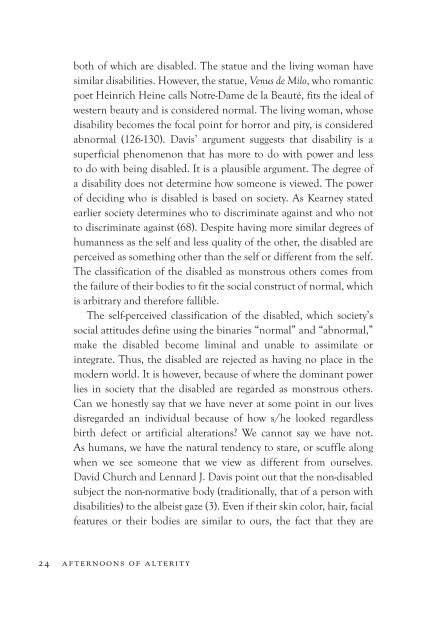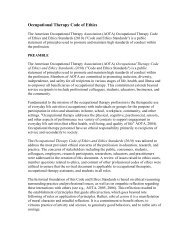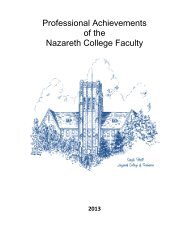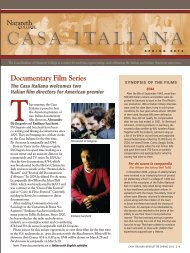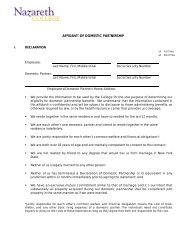Afternoon of Alterity - Nazareth College
Afternoon of Alterity - Nazareth College
Afternoon of Alterity - Nazareth College
Create successful ePaper yourself
Turn your PDF publications into a flip-book with our unique Google optimized e-Paper software.
oth <strong>of</strong> which are disabled. The statue and the living woman havesimilar disabilities. However, the statue, Venus de Milo, who romanticpoet Heinrich Heine calls Notre-Dame de la Beauté, fits the ideal <strong>of</strong>western beauty and is considered normal. The living woman, whosedisability becomes the focal point for horror and pity, is consideredabnormal (126-130). Davis’ argument suggests that disability is asuperficial phenomenon that has more to do with power and lessto do with being disabled. It is a plausible argument. The degree <strong>of</strong>a disability does not determine how someone is viewed. The power<strong>of</strong> deciding who is disabled is based on society. As Kearney statedearlier society determines who to discriminate against and who notto discriminate against (68). Despite having more similar degrees <strong>of</strong>humanness as the self and less quality <strong>of</strong> the other, the disabled areperceived as something other than the self or different from the self.The classification <strong>of</strong> the disabled as monstrous others comes fromthe failure <strong>of</strong> their bodies to fit the social construct <strong>of</strong> normal, whichis arbitrary and therefore fallible.The self-perceived classification <strong>of</strong> the disabled, which society’ssocial attitudes define using the binaries “normal” and “abnormal,”make the disabled become liminal and unable to assimilate orintegrate. Thus, the disabled are rejected as having no place in themodern world. It is however, because <strong>of</strong> where the dominant powerlies in society that the disabled are regarded as monstrous others.Can we honestly say that we have never at some point in our livesdisregarded an individual because <strong>of</strong> how s/he looked regardlessbirth defect or artificial alterations? We cannot say we have not.As humans, we have the natural tendency to stare, or scuffle alongwhen we see someone that we view as different from ourselves.David Church and Lennard J. Davis point out that the non-disabledsubject the non-normative body (traditionally, that <strong>of</strong> a person withdisabilities) to the albeist gaze (3). Even if their skin color, hair, facialfeatures or their bodies are similar to ours, the fact that they are24 afternoons <strong>of</strong> alterity


